airbag VOLKSWAGEN TRANSPORTER 2021 Owners Manual
[x] Cancel search | Manufacturer: VOLKSWAGEN, Model Year: 2021, Model line: TRANSPORTER, Model: VOLKSWAGEN TRANSPORTER 2021Pages: 486, PDF Size: 69.28 MB
Page 2 of 486
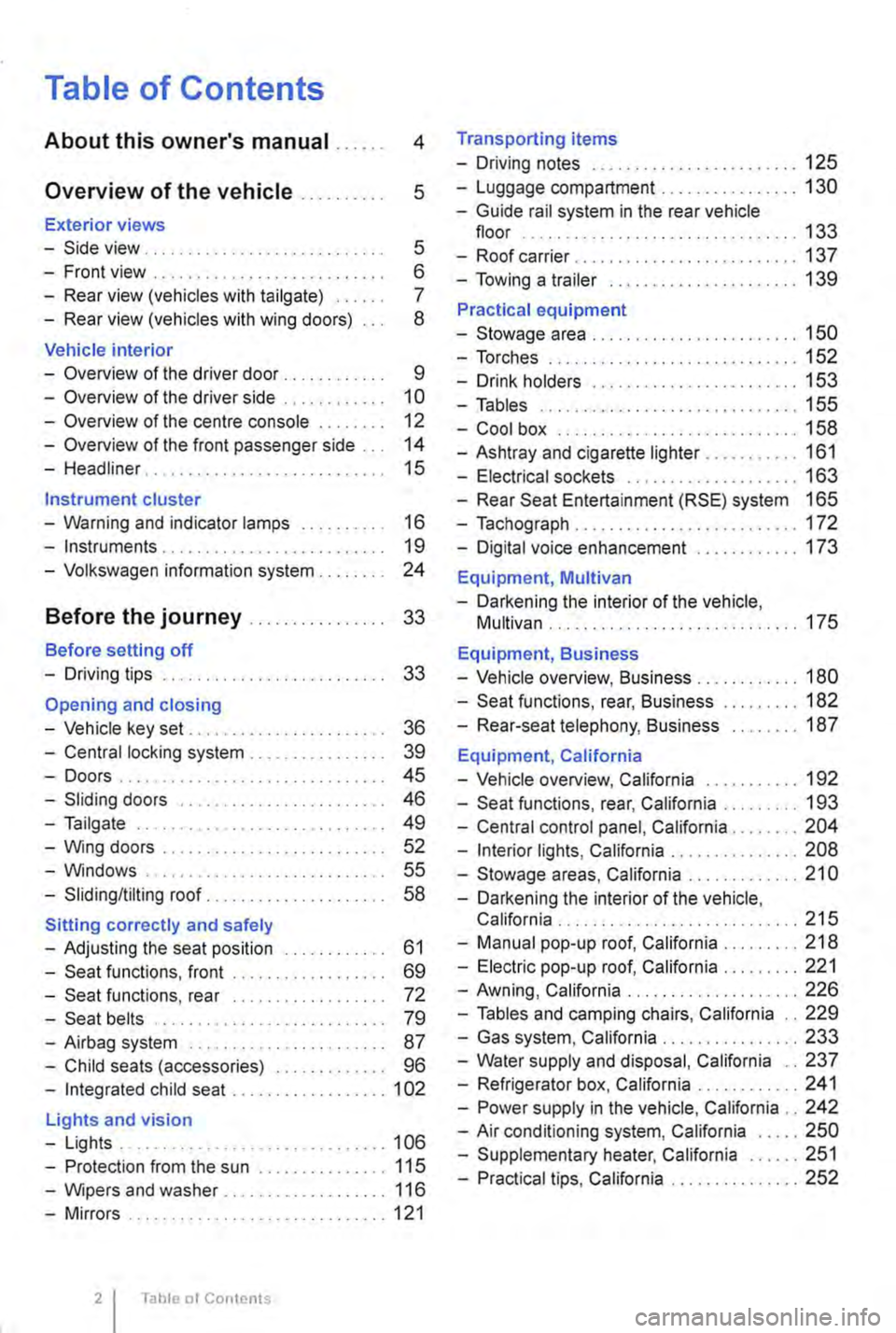
Table of Contents
About this owner's manual . . . . . . 4
Overview of the vehicle . . . . . . . . . . 5
Exterior views
-Side view . . . . . . . . . . . . . . . . . . . . . . . . . . . . 5
-Front view . . . . . . . . . . . . . . . . . . . . . . . . . . . 6
-Rear view (vehicles with tailgate) . . . . . 7
-Rear view (vehicles with wing doors) 8
Vehicle interior
-Overview of the driver door . . . . . . . . . . . 9
-Overview of the driver side . . . . . . . . . . . 10
-Overview of the centre console . . 12
-Overview of the front passenger side . . . 14
-Headliner . . . . . . . . . . . . . . . . . . . . 15
Instrument cluster
-Warning and indicator lamps . . . . . . . . . . 16
-Instruments . . . . . . . . . . . . . . . . . . . . . . . . . . 19
-Volkswagen information system . . . . . . . . 24
Before the journey . . . . . . . . . . . . . . . . 33
Before setting off
-Driving tips . . . . . . . . . . . . . . . . . . . . . . . . . . 33
Opening and closing
-Vehicle key set . . . . . . . . . . . . . . . . . . . . . . . 36
-Central locking system . . . . . . . . . . . . . . . . 39
-Doors.... . . . . . . . . . . . . . . . . . . . . . . . . . 45
-Sliding doors . . . . . . . . . . . . . . . . . . . . . . . . 46
-Tailgate . . . . . . . . . . . . . . . . . . . . . . . . . . . . 49
-Wing doors . . . . . . . . . . . . . . . . . . . . . . . . . 52
-Windows . . . . . . . . . . . . . . . . . . . . . . . . . 55
-Sliding/tilting roof. . . . . . . . . . . . . . . . 58
Sitting correctly and safely
-Adjusting the seat position . . . . . . . . . . . . 61
-Seat functions, front . . . . . . . . . . . . . . . . . . 69
-Seat functions, rear . . . . . . . . . . . . . . . . . . 72
-Seat belts . . . . . . . . . . . . . . . . . . . . . . . . . . 79
-Airbag system . . . . . . . . . . . . . . . . . . . . . . . 87
-Child seats (accessories) . . . . . . . . . . . . . 96
-Integrated child seat .................. 1 02
Lights and vision
-Lights ............................... 106
-Protection from the sun ............... 115
-Wipers and washer . . . . . . . . . . . . . 116
-Mirrors .............................. 121
Table ot Contents
Transporting items
-Driving notes ........................ 125
-Luggage compartment ................ 130
-Guide rail system in the rear vehicle floor ................................ 133
-Roof carrier ........ , ................. 137
-Towing a trailer ...................... 139
Practical equipment
-Stowage area ........................ 150
-Torches ............................. 152
-Drink holders . . . • . . . . . . . . . . . . . . . . . . 153
-Tables .............................. 155
-Cool box ............................ 158
-Ashtray and cigarette lighter ........... 161
-Electrical sockets . . . . . . . . . . . . . . . . . . . . 163
-Rear Seat Entertainment (RSE) system 165
-Tachograph . . . . . . . . . . . . . . . . . . . . . . . . . . 172
-Digital voice enhancement ............ 173
Equipment, Multivan
-Darkening the interior of the vehicle, Multivan ............................. 175
Equipment, Business
-Vehicle overview, Business . . . . . . . . . . . . 180
-Seat functions, rear, Business ......... 182
-Rear-seat telephony, Business ........ 187
Equipment, California
-Vehicle overview, California . . . . . . . . . . . 192
-Seat functions, rear, California ......... 193
-Central control panel, California ........ 204
-Interior lights, California ............... 208
-Stowage areas, California ............. 21 0
-Darkening the interior of the vehicle, California . . . . . . . . ................... 215
-Manual pop-up roof, California ......... 218
-Electric pop-up roof, California ......... 221
-Awning, California .................... 226
-Tables and camping chairs, California .. 229
-Gas system, California ................ 233
-Water supply and disposal, California .. 237
-Refrigerator box, California ............ 241
-Power supply in the vehicle, California .. 242
-Air conditioning system, California ..... 250
-Supplementary heater, California ...... 251
-Practical tips, California ............... 252
Page 11 of 486
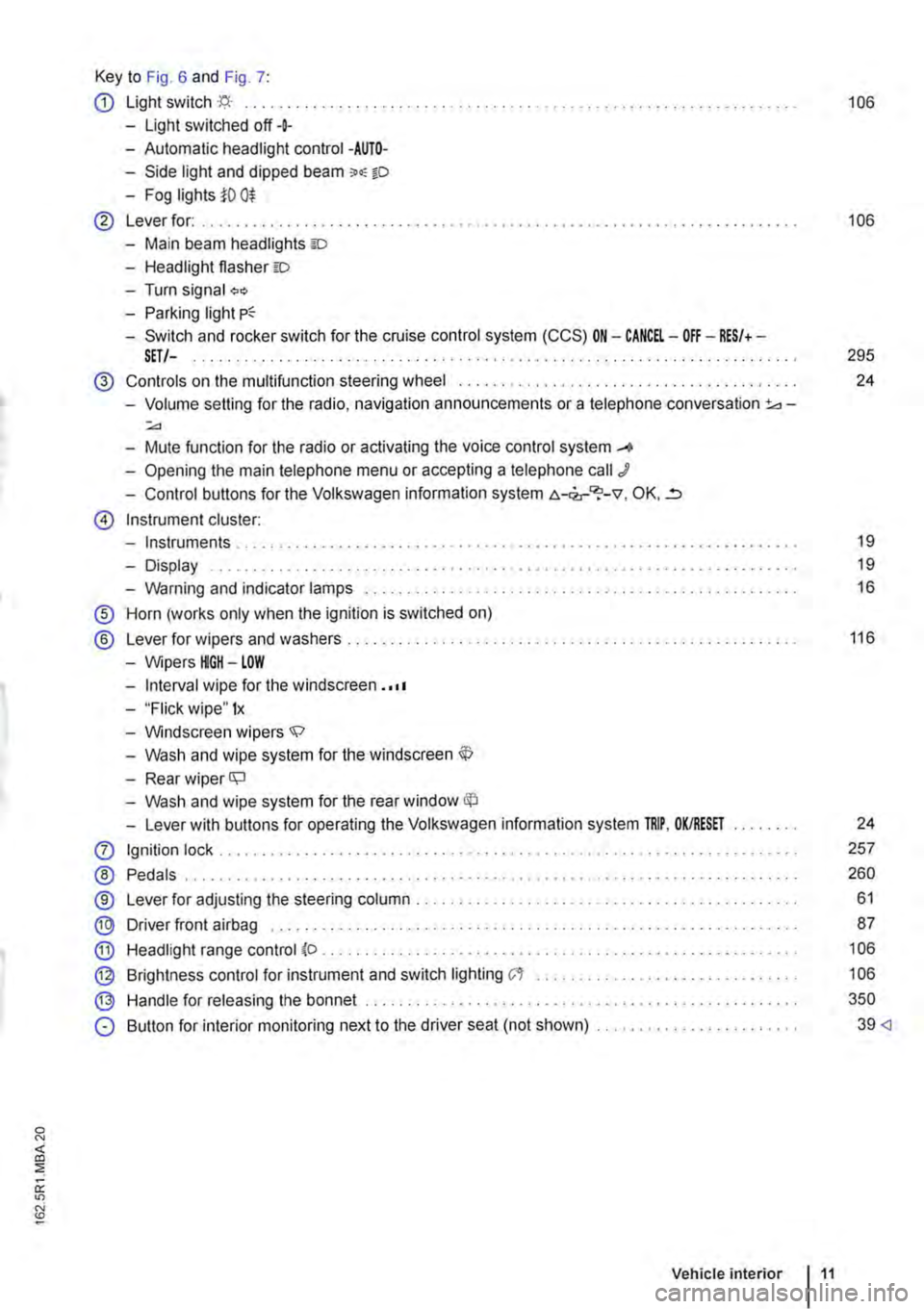
Key to Fig. 6 and Fig. 7:
CD Light switch ·'f;i.· ... 106
-Light switched off+
-Automatic headlight control -AUTO-
-Side light and dipped beam o.-o
-Fog lights i'O 0$
@ Lever for: .......... . 106
-Main beam headlights ID
-Headlight flasher =:o
-Turn signal "'" -Parking light
-Switch and rocker switch for the cruise control system (CCS) ON-CANCEL-OFF-RES/+-SET/-. . . . . . . . . . . . . . . . . . . . . . . . . . . . . . . . . . . . . . . . . . . . . . . . . . . . 295
@ Controls on the multifunction steering wheel ....... .
-Volume setting for the radio, navigation announcements or a telephone conversation 3d-:;.,
-Mute function for the radio or activating the voice control system _...
-Opening the main telephone menu or accepting a telephone call J
-Control buttons for the Volkswagen information system c.-<2,-"?-v, OK, ..=,
@ Instrument cluster:
-Instruments ..
-Display
-Warning and indicator lamps ..... .
® Horn (works only when the ignition is switched on)
® Lever for wipers and washers . . . . . .....................................•
-Wipers HGH-LOW
-Interval wipe for the windscreen . ·••
-"Flick wipe" 1x
-Windscreen wipers.;;:>
-Wash and wipe system for the windscreen
-Rear wiper ll;J
-Wash and wipe system for the rear window
-Lever with buttons for operating the Volkswagen information system TRIP, OK/RESET
0 Ignition lock .......... .
® Pedals .................. .
®
® @
Lever for adjusting the steering column ..................•.....
Driver front airbag ........ .
Headlight range control (o .
Brightness control for instrument and switch lighting C't ...••.•...
Handle for releasing the bonnet ...
@
®
0 Button for interior monitoring next to the driver seat (not shown) ....................... .
Vehicle interior 11
24
19
19
16
116
24
257
260
61
87
106
106
350
39
Page 12 of 486
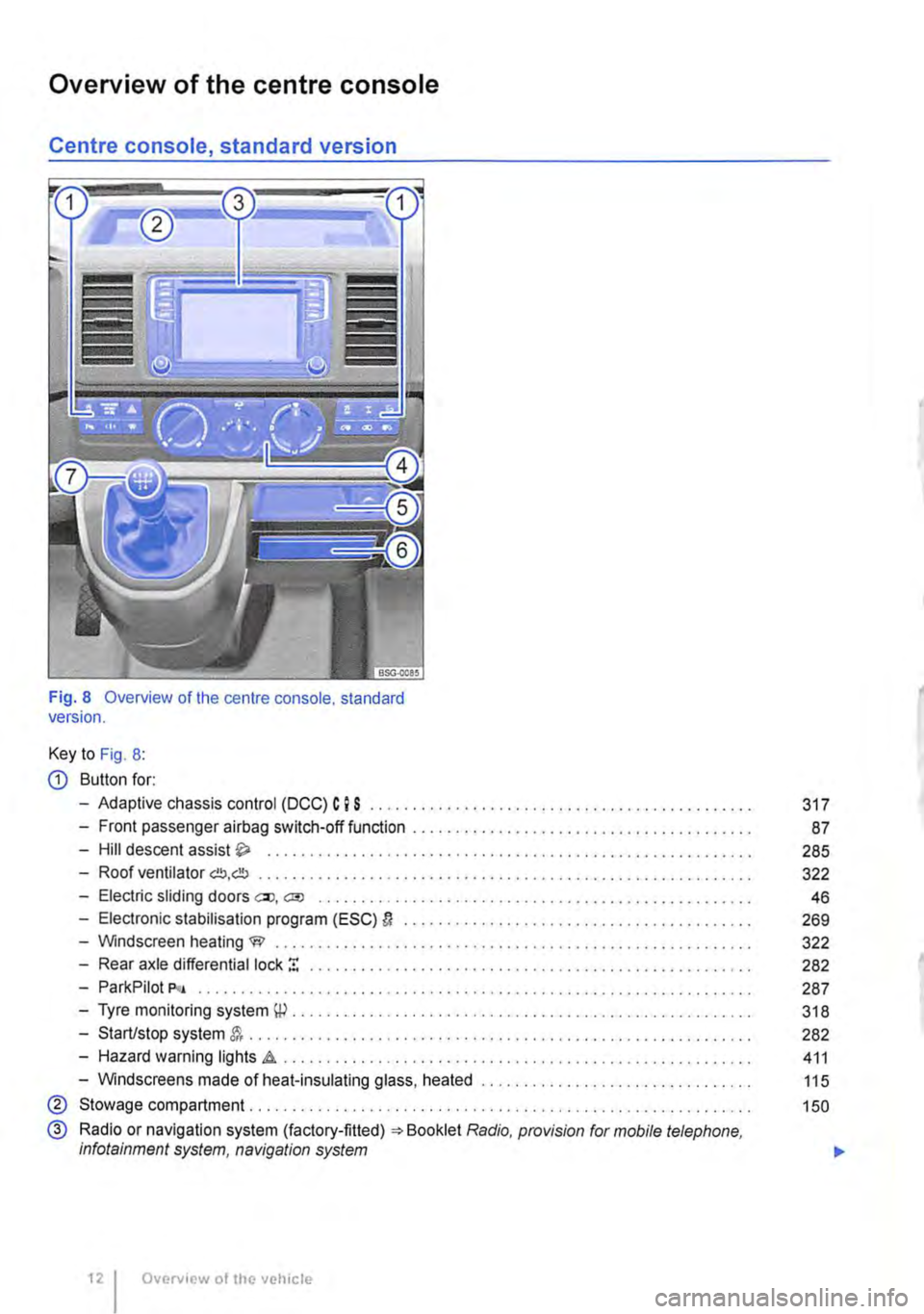
Overview of the centre console
Centre console, standard version
Fig. 8 Overview of the centre console. standard version.
Key to Fig. 8:
CD Button for:
-Adaptive chassis control (DCC) C I S .......................................... .
-Front passenger airbag switch-off function ................•.......................
-Hill descent assist .................................•.......................
-Roof ventilator G!!J,db ......................................................... .
-Electric sliding doors ell, a;o ............................................••....•
-Electronic stabilisation program (ESC) D ........................................ .
-Windscreen heating W ..................•...................................
-Rear axle differential lock ! ................................................. .
-ParkPilot P<• .....................•..••••.............••..............•••••.
-Tyre monitoring system \P . . . . . . . . . . . . . . . . . . . . . . . . ........................ .
-Start/stop system . . . . . . . . . . . . . . . . . . . . . . . . ............................... .
-Hazard warning lights .a . . . . . . . . . . . . . . . . . . . ............................ .
-Windscreens made of heat-insulating glass, heated ............................... .
® Stowage compartment. . . . . . . . . . . . . . . . ............... .
@ Radio or navigation system (factory-fitted) =:-Booklet Radio, provision for mobile telephone, infotainment system, navigation system
Overview of the vehicle
317
87
285
322
46
269
322
282
287
318
282
411
115
150
...
Page 13 of 486
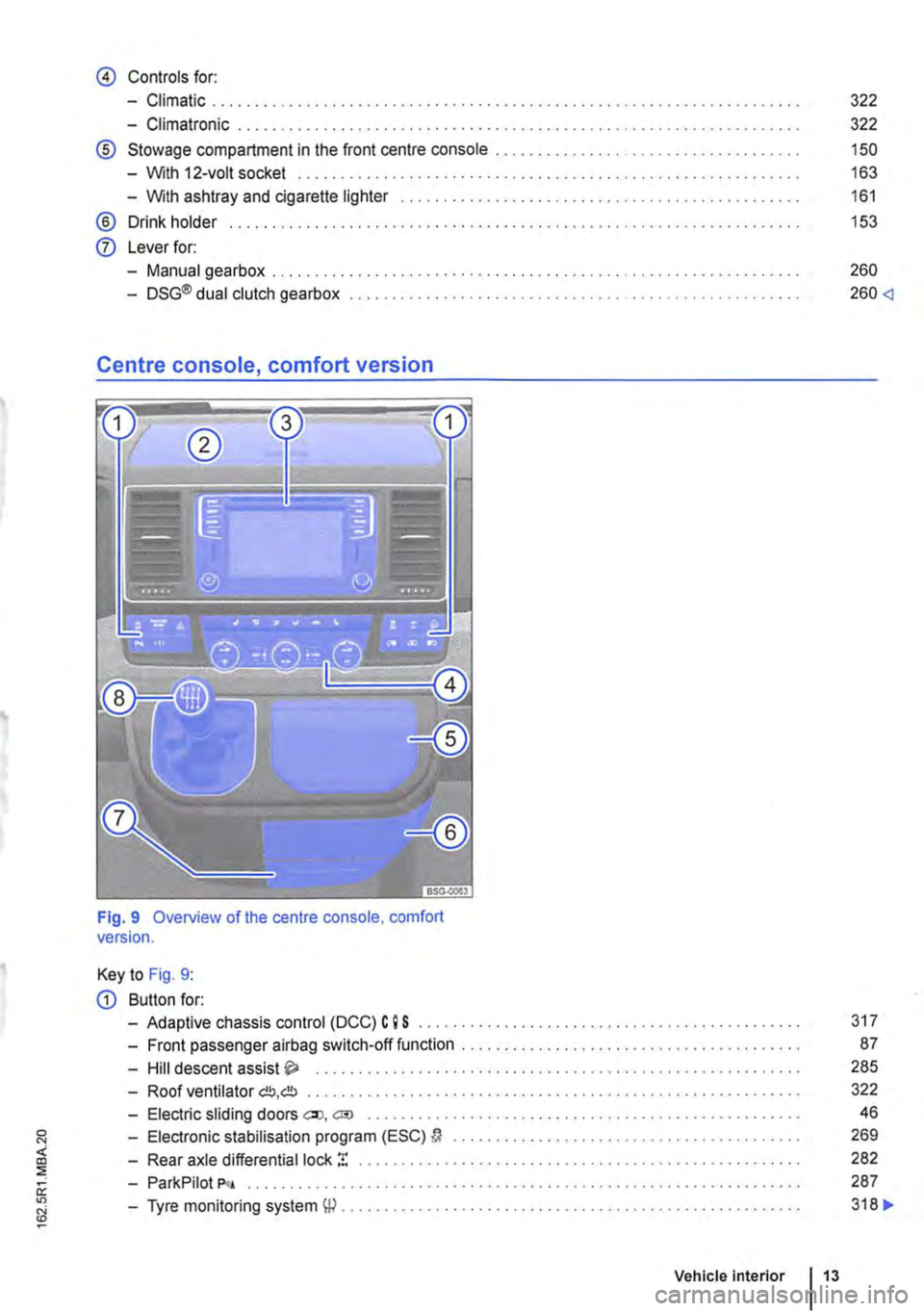
@ Controls for:
-Climatic .................................................................... .
-Climatronic ............................................•.....................
® Stowage compartment in the front centre console ...... .
-With 12-volt socket ...................... .
-With ashtray and cigarette lighter
® Drink holder ..
0 Lever for:
-Manual gearbox . . . . . . . . . . . . . . . . . . . . . . . . . . . . . . . . . . . . . . . . . . . . . ........ .
-DSG® dual clutch gearbox .................................................. .
Centre console, comfort version
Fig. 9 Overview of the centre console, comfort version.
Key to Fig. 9:
G) Button for:
-Adaptive chassis control (DCC) C 9 S
-Front passenger airbag switch-off function
-Hill descent assist ..... .
322
322
150
163
161
153
260
260
87
285
-Roof ventilator C!J,C!J . . . . . . . . . . . . . . . . . . • . . . . . . . . . . . . . • . • . . . . . . . . . . . • • . • • . • . . 322
-Electric sliding doors eo, cm . . . . . . . . . . . . . . . . . . . . . . . . . . . . . . . . . . . . . . . . . . . . . . 46
-Electronic stabilisation program (ESC) a . . . . . . . . . . . . . . . . . . . . . . 269
-Rear axle differential lock ! . . . . . . . . . . . . . . . . . . . . . . . . . . 282
-ParkPilot P<•
-Tyre monitoring system W .............. .
Vehicle Interior 13
287
318 ..
Page 15 of 486
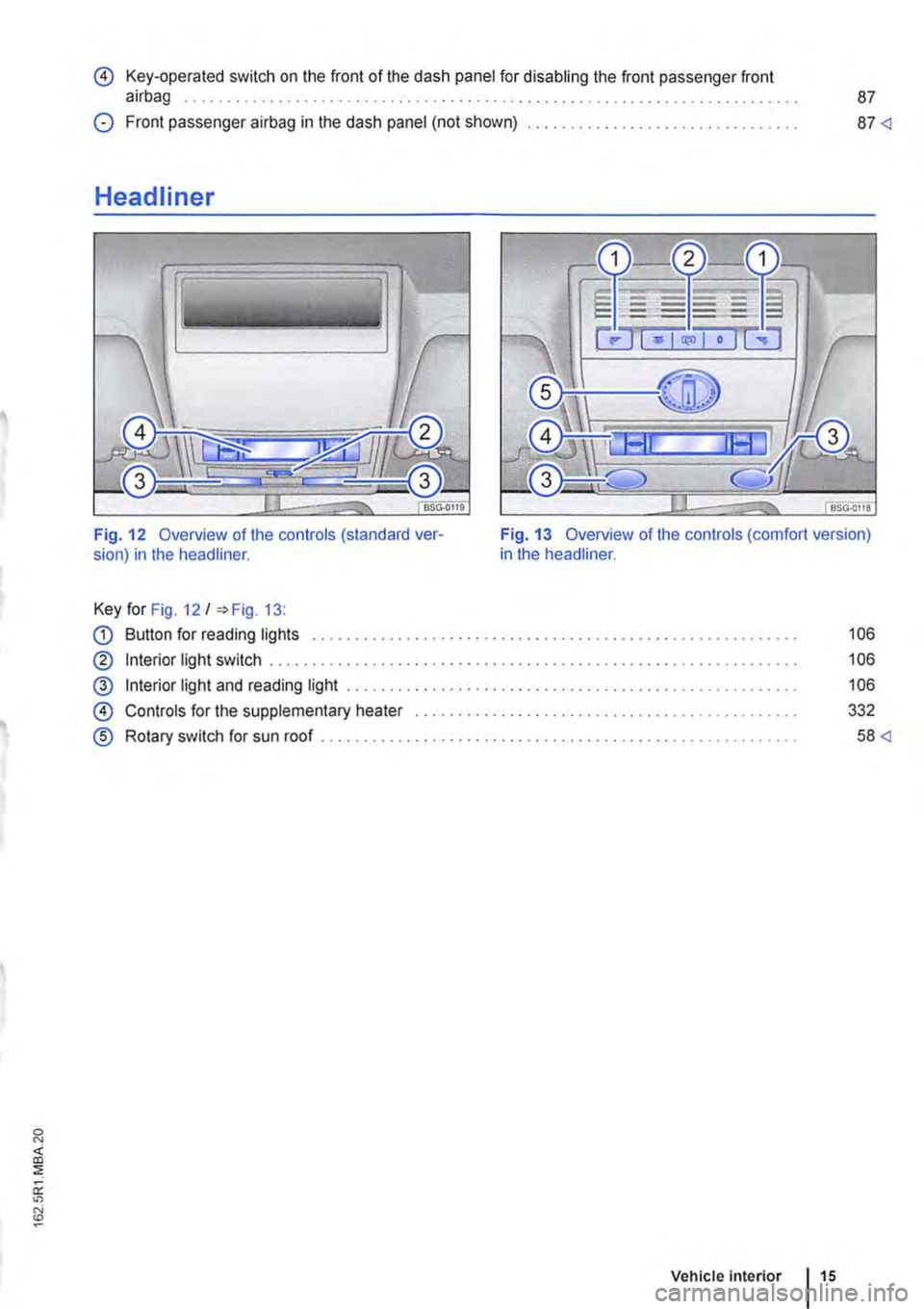
0 Key-operated switch on the front of the dash panel for disabling the front passenger front airbag . . . . . . . . . . . . . . . . . . . . . . . . . . . . 87
0 Front passenger airbag in the dash panel (not shown) .. 87
Headliner
I 11 l ______
Fig. 12 Overview of the controls (standard ver-sion) in the headliner.
Key for Fig. 12/ =>Fig. 13:
CD Button for reading lights ............. .
® Interior light switch . . . . . . ......... .
@ Interior light and reading light ... .
0 Controls for the supplementary heater
® Rotary switch for sun roof ..... .
Fig. 13 Overview of the controls (comfort version) in the headliner.
Vehicle Interior 15
106
106
106
332
58
Page 17 of 486
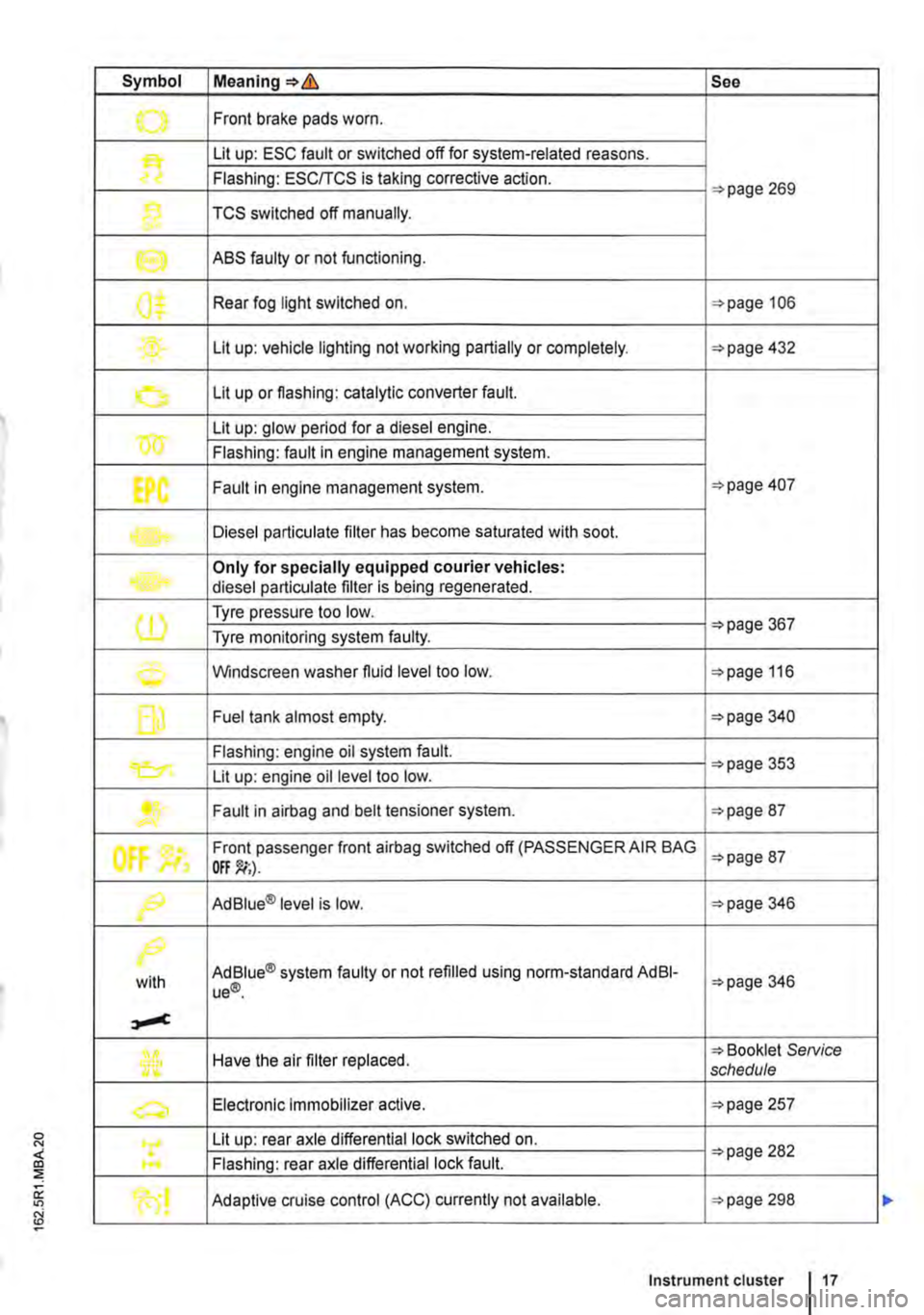
Symbol Meaning=>& See
.......,. Front brake pads worn .
Lit up: ESC fault or switched off for system-related reasons.
Flashing: ESC/TCS is taking corrective action. =>page 269
1} TCS switched off manually.
e ABS faulty or not functioning.
0$ Rear fog light switched on. =>page 106
Lit up: vehicle lighting not working partially or completely. =>page 432
0 Lit up or flashing: catalytic converter fault.
w Lit up: glow period for a diesel engine.
Flashing: fault in engine management system.
EPC Fault in engine management system. =>page 407
Diesel particulate filter has become saturated with soot.
Only for specially equipped courier vehicles: diesel particulate filter is being regenerated.
(1) Tyre pressure too low. =>page 367 Tyre monitoring system faulty.
0 Windscreen washer fluid level too low. =>page 116
f] Fuel tank almost empty. =>page 340
Flashing: engine oil system fault.
Lit up: engine oil level too low. =>page 353
....... Fault in airbag and belt tensioner system. =>page 87
tf'
Front passenger front airbag switched off (PASSENGER AIR BAG =>page 87
f9 Ad Blue® level is low. =>page 346
/>.
with Ad Blue® system faulty or not refilled using norm-standard AdBI-ue®. =>page 346
Have the air filter replaced. => Booklet SeNice schedule
a, Electronic Immobilizer active. =>page 257
Lit up: rear axle differential lock switched on. =>page 282 .... Flashing: rear axle differential lock fault.
Adaptive cruise control (ACC) currently not available. =>page 298
Instrument cluster 17
Page 61 of 486
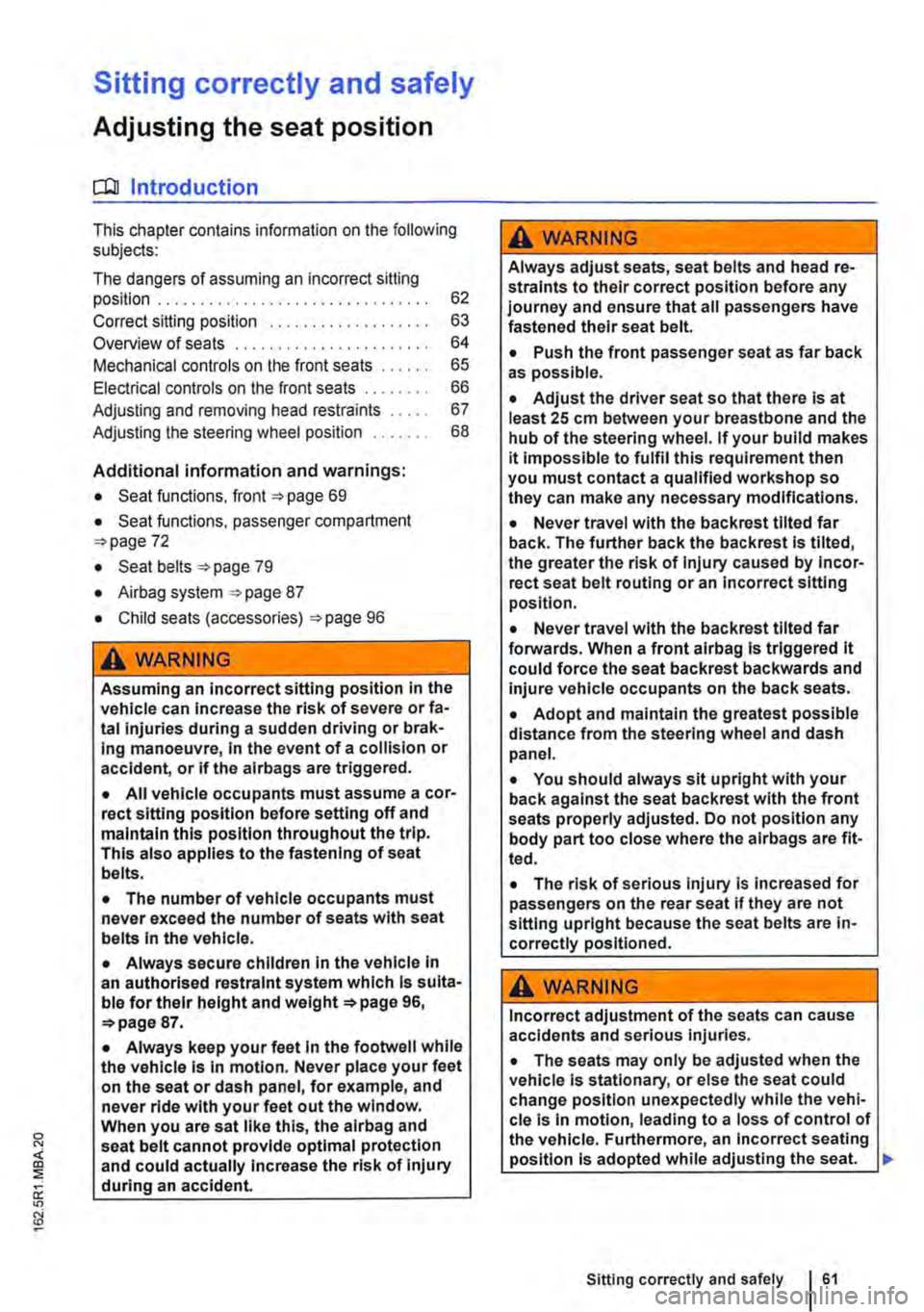
Sitting correctly and safely
Adjusting the seat position
COl Introduction
This chapter contains information on the following subjects:
The dangers of assuming an incorrect sitting position . . . .............. .
Correct sitting position . . . . . . ......... . Overview of seats ...................... .
Mechanical controls on the front seats ..... .
Electrical controls on the front seats ....... . Adjusting and removing head restraints .... .
Adjusting the steering wheel position ...... .
Additional information and warnings:
• Seat functions, front 69
• Seat functions, passenger compartment 72
• Seat belts 79
• Airbag system 87
• Child seats (accessories) 96
A WARNING
62
63
64
65
66
67
68
Assuming an incorrect sitting position in the vehicle can increase the risk of severe or fa-tal injuries during a sudden driving or brak-ing manoeuvre, in the event of a collision or accident, or if the airbags are triggered.
• All vehicle occupants must assume a cor-rect sitting position before setting off and maintain this position throughout the trip. This also applies to the fastening of seat belts.
• The number of vehicle occupants must never exceed the number of seats with seat belts in the vehicle.
• Always secure children in the vehicle in an authorised restraint system which Is suita-ble for their height and page 96, 87.
• Always keep your feet in the footweli while the vehicle is in motion. Never place your feet on the seat or dash panel, for example, and never ride with your feet out the window. When you are sat like this, the airbag and seat belt cannot provide optimal protection and could actually increase the risk of Injury during an accident.
A WARNING
Always adjust seats, seat belts and head re-straints to their correct position before any journey and ensure that ail passengers have fastened their seat belt.
• Push the front passenger seat as far back as possible.
• Adjust the driver seat so that there is at least 25 cm between your breastbone and the hub of the steering wheel. If your build makes it impossible to fulfil this requirement then you must contact a qualified workshop so they can make any necessary modifications.
• Never travel with the back rest tilted far back. The further back the backrest is tilted, the greater the risk of injury caused by incor-rect seat belt routing or an incorrect sitting position.
• Never travel with the back rest tilted far forwards. When a front airbag is triggered it could force the seat backrest backwards and injure vehicle occupants on the back seats.
• Adopt and maintain the greatest possible distance from the steering wheel and dash panel.
• You should always sit upright with your back against the seat back rest with the front seats properly adjusted. Do not position any body part too close where the airbags are fit-ted.
• The risk of serious injury Is increased for passengers on the rear seat if they are not sitting upright because the seat belts are in-correctly positioned.
A WARNING
Incorrect adjustment of the seats can cause accidents and serious injuries.
• The seats may only be adjusted when the vehicle is stationary, or else the seat could change position unexpectedly while the vehi-cle is in motion, leading to a loss of control of the vehicle. Furthermore, an incorrect seating position is adopted while adjusting the seat. .,.
Sitting correctly and safely 61
Page 62 of 486
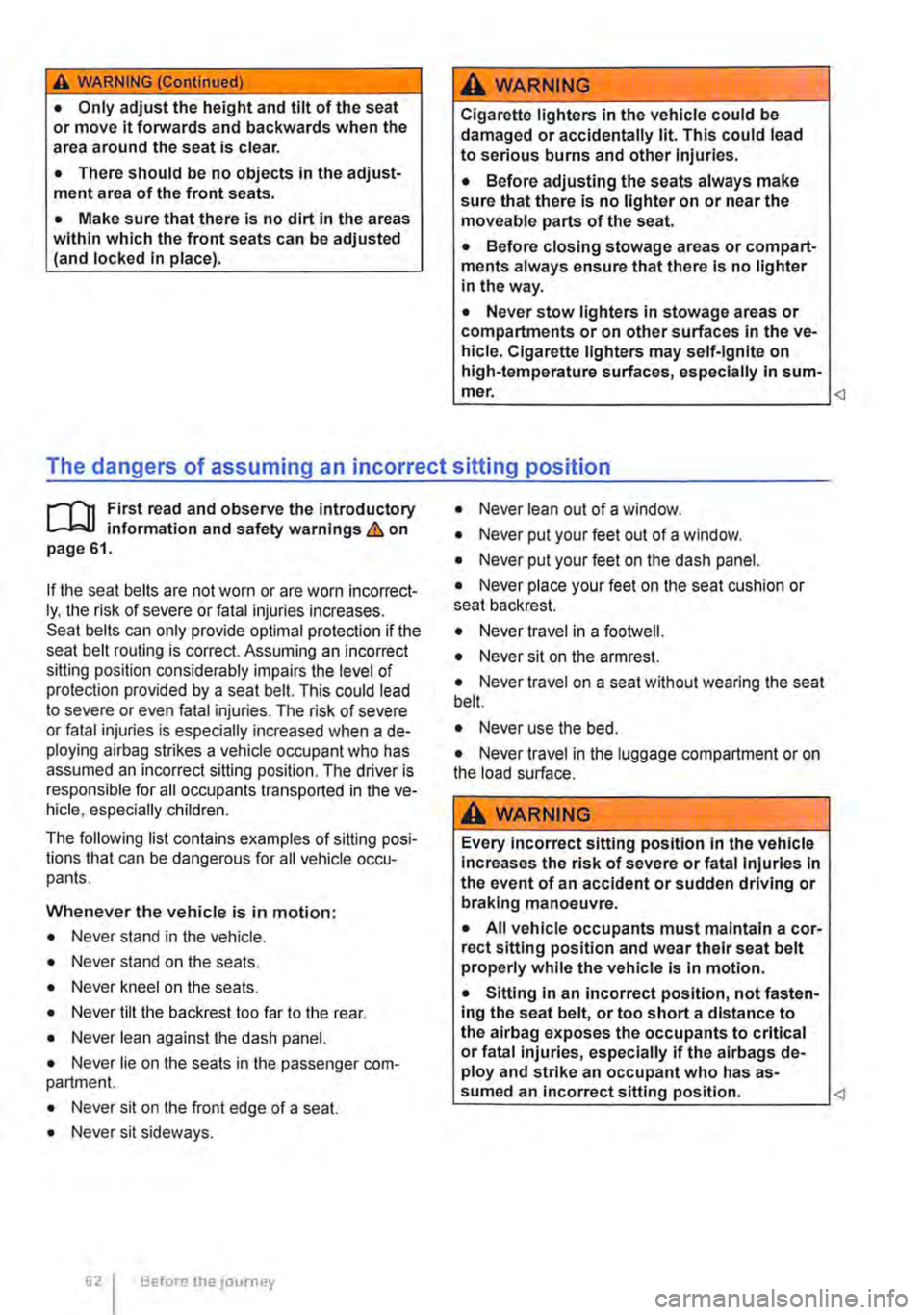
A WARNING (Continued)
• Only adjust the height and tilt of the seat or move lt forwards and backwards when the area around the seat is clear.
• There should be no objects in the adjust-ment area of the front seats.
• Make sure that there is no dirt in the areas within which the front seats can be adjusted (and locked In place).
A WARNING
Cigarette lighters in the vehicle could be damaged or accidentally lit. This could lead to serious burns and other Injuries.
• Before adjusting the seats always make sure that there is no lighter on or near the moveable parts of the seat.
• Before closing stowage areas or compart-ments always ensure that there Is no lighter in the way.
• Never stow lighters in stowage areas or compartments or on other surfaces In the ve-hicle. Cigarette lighters may self-Ignite on high-temperature surfaces, especially In sum-
The dangers of assuming an incorrect sitting position
.....-m First read and observe the Introductory L-.bU information and safety warnings & on page 61.
If the seat belts are not worn or are worn incorrect-ly, the risk of severe or fatal injuries increases. Seat belts can only provide optimal protection if the seat belt routing is correct. Assuming an incorrect sitting position considerably impairs the level of protection provided by a seat belt. This could lead to severe or even fatal injuries. The risk of severe or fatal injuries is especially increased when a de-ploying airbag strikes a vehicle occupant who has assumed an incorrect sitting position. The driver is responsible for all occupants transported in the ve-hicle, especially children.
The following list contains examples of sitting posi-tions that can be dangerous for all vehicle occu-pants.
Whenever the vehicle is in motion:
• Never stand in the vehicle.
• Never stand on the seats.
• Never kneel on the seats.
• Never tilt the backrest too far to the rear.
• Never lean against the dash panel.
• Never lie on the seats in the passenger com-partment.
• Never sit on the front edge of a seat.
• Never sit sideways.
Before the journey
• Never lean out of a window .
• Never put your feet out of a window.
• Never put your feet on the dash panel.
• Never place your feet on the seat cushion or seat backrest.
• Never travel in a footwell.
• Never sit on the armrest.
• Never travel on a seat without wearing the seat belt.
• Never use the bed.
• Never travel in the luggage compartment or on the load surface.
A WARNING
Every Incorrect sitting position In the vehicle Increases the risk of severe or fatal Injuries In the event of an accident or sudden driving or braking manoeuvre.
• All vehicle occupants must maintain a cor-rect sitting position and wear their seat belt properly while the vehicle Is In motion.
• Sitting In an incorrect position, not fasten-ing the seat belt, or too short a distance to the alrbag exposes the occupants to critical or fatal injuries, especially if the alrbags de-ploy and strike an occupant who has as-sumed an Incorrect sitting position.
Page 63 of 486
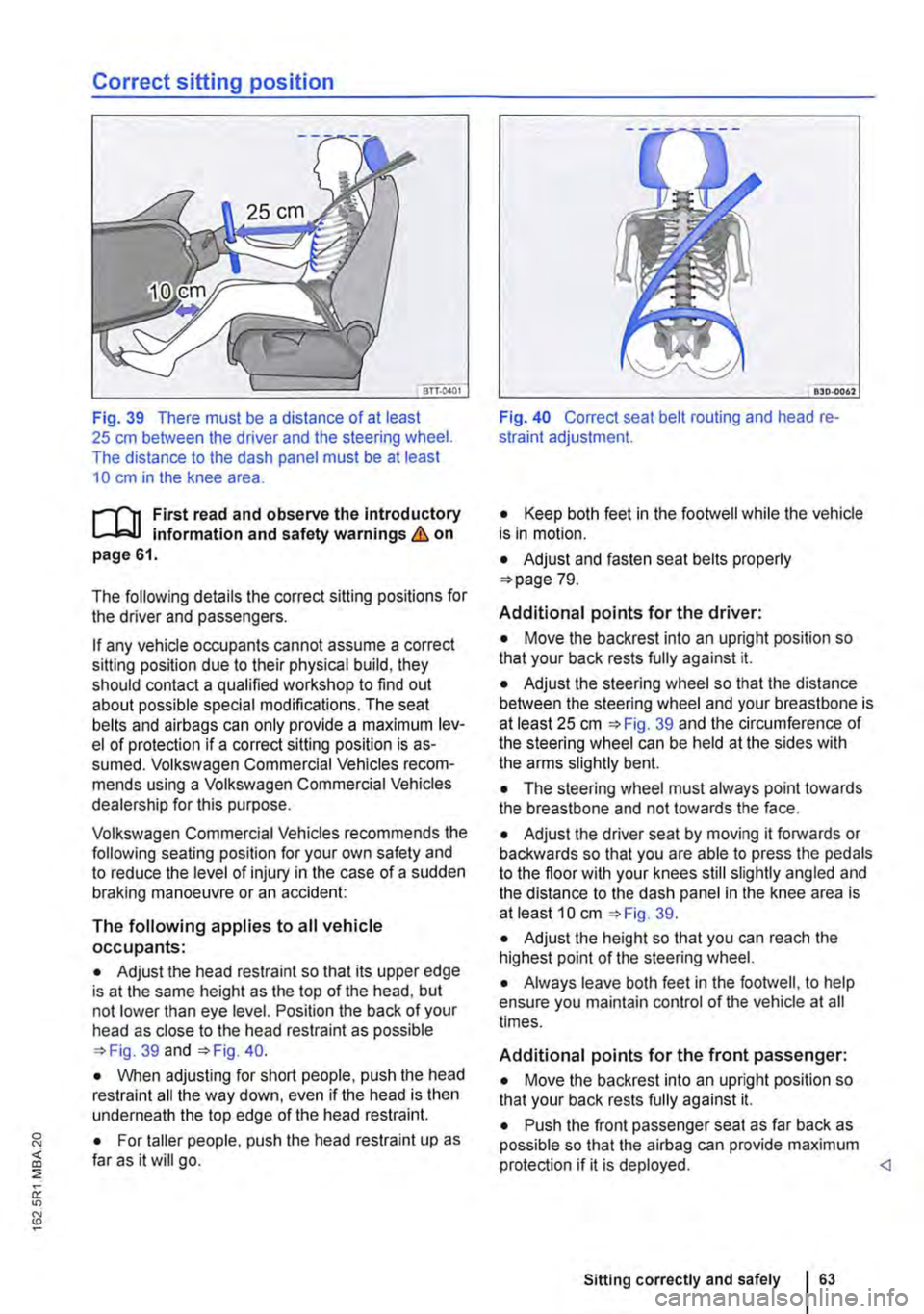
Correct sitting position
Fig. 39 There must be a distance of at least 25 cm between the driver and the steering wheel. The distance to the dash panel must be at least 10 cm in the knee area.
f"'"""('n First read and observe the introductory L-Jc..l.l Information and safety warnings & on page 61.
The following details the correct sitting positions for the driver and passengers.
If any vehicle occupants cannot assume a correct sitting position due to their physical build, they should contact a qualified workshop to find out about possible special modifications. The seat belts and airbags can only provide a maximum lev-el of protection if a correct sitting position is as-sumed. Volkswagen Commercial Vehicles recom-mends using a Volkswagen Commercial Vehicles dealership for this purpose.
Volkswagen Commercial Vehicles recommends the following seating position for your own safety and to reduce the level of injury in the case of a sudden braking manoeuvre or an accident:
The following applies to all vehicle occupants:
• Adjust the head restraint so that its upper edge is at the same height as the top of the head, but not lower than eye level. Position the back of your head as close to the head restraint as possible 39 and 40.
• When adjusting for short people, push the head restraint all the way down, even if the head is then underneath the top edge of the head restraint.
• For taller people, push the head restraint up as far as it will go.
Fig. 40 Correct seat belt routing and head re-straint adjustment.
• Keep both feet in the footwell while the vehicle is in motion.
• Adjust and fasten seat belts properly 79.
Additional points for the driver:
• Move the backrest into an upright position so that your back rests fully against it.
• Adjust the steering wheel so that the distance between the steering wheel and your breastbone is at least 25 cm 39 and the circumference of the steering wheel can be held at the sides with the arms slightly bent.
• The steering wheel must always point towards the breastbone and not towards the face.
• Adjust the driver seat by moving it forwards or backwards so that you are able to press the pedals to the floor with your knees still slightly angled and the distance to the dash panel in the knee area is at least 10 cm 39.
• Adjust the height so that you can reach the highest point of the steering wheel.
• Always leave both feet in the footwell, to help ensure you maintain control of the vehicle at all times.
Additional points for the front passenger:
• Move the backrest into an upright position so that your back rests fully against it.
• Push the front passenger seat as far back as possible so that the airbag can provide maximum protection if it is deployed.
Page 65 of 486
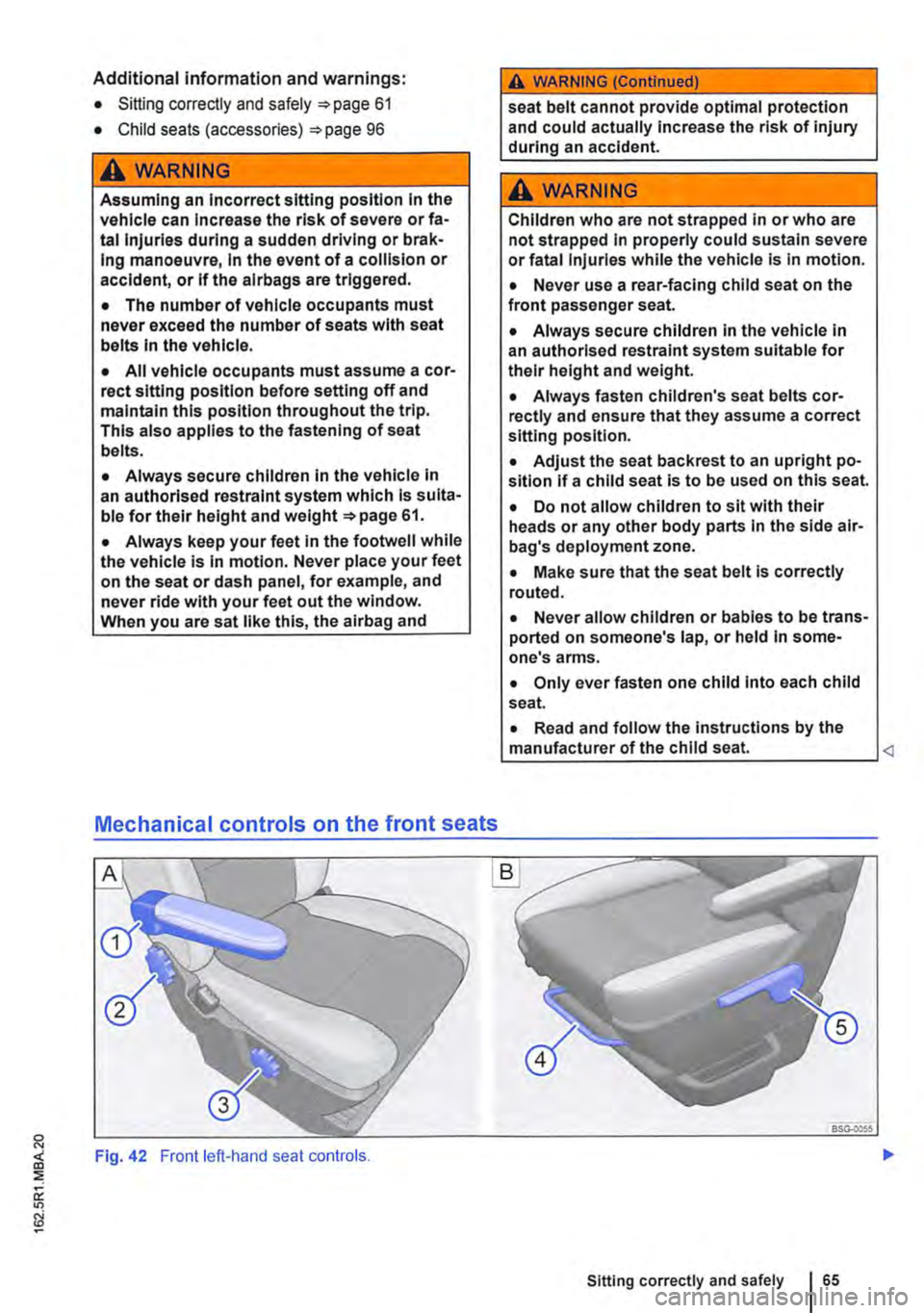
Additional information and warnings:
• Sitting correctly and safely 61
• Child seats (accessories) 96
A WARNING
Assuming an Incorrect sitting position In the vehicle can Increase the risk of severe or fa-tal injuries during a sudden driving or brak-Ing manoeuvre, In the event of a collision or accident, or If the alrbags are triggered.
• The number of vehicle occupants must never exceed the number of seats with seat belts In the vehicle.
• All vehicle occupants must assume a cor-rect sitting position before setting off and maintain this position throughout the trip. This also applies to the fastening of seat belts.
• Always secure children in the vehicle in an authorised restraint system which is suita-ble for their height and page 61.
• Always keep your feet in the footwell while the vehicle is in motion. Never place your feet on the seat or dash panel, for example, and never ride with your feet out the window. When you are sat like this, the airbag and
Mechanical controls on the front seats
Fig. 42 Front left-hand seat controls.
A WARNING (Continued)
seat belt cannot provide optimal protection and could actually increase the risk of injury during an accident.
A WARNING
Children who are not strapped in or who are not strapped in properly could sustain severe or fatal Injuries while the vehicle Is In motion.
• Never use a rear-facing child seat on the front passenger seat.
• Always secure children in the vehicle in an authorised restraint system suitable for their height and weight.
• Always fasten children's seat belts cor-rectly and ensure that they assume a correct sitting position.
• Adjust the seat backrest to an upright po-sition If a child seat is to be used on this seat.
• Do not allow children to sit with their heads or any other body parts in the side air-bag's deployment zone.
• Make sure that the seat belt is correctly routed.
• Never allow children or babies to be trans-ported on someone's lap, or held in some-one's arms.
• Only ever fasten one child Into each child seat.
• Read and follow the instructions by the manufacturer of the child seat.